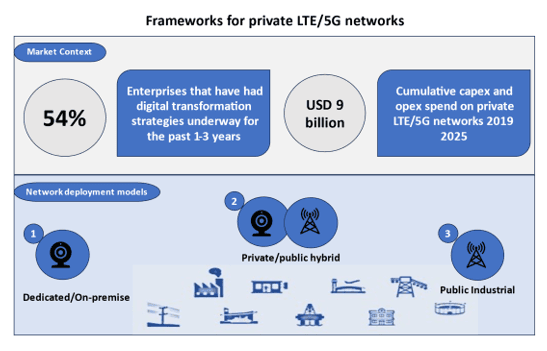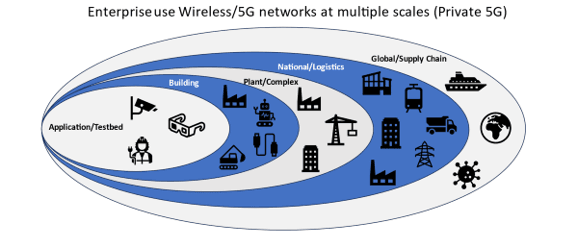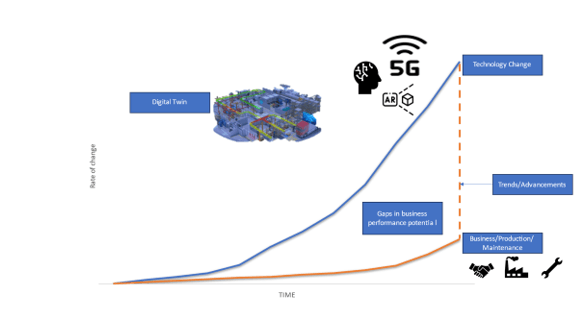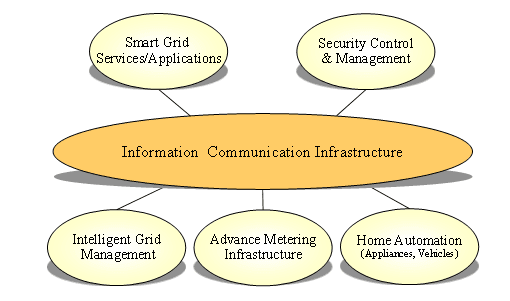Powerful Possibilities: Exploring the Game-Changing Effects of Private 5G Adoption
Author: Himanshu Patni
25 October 2023
Private 5G is a revolutionary technology that is being adopted by businesses to enable digital transformation and increased efficiency. This cutting-edge network can facilitate connections between devices, automate processes, and reduce expenses. Private 5G is especially advantageous for applications requiring outdoor usage or dedicated, licensed spectrum. As such, it is being heavily utilized in the manufacturing, transport and logistics, mining, and oil and gas industries. Companies that adopt this technology can benefit from reduced costs, energy savings, improved safety and security, and the ability to develop novel applications such as autonomous vehicles, drones, and robotics. Enterprises that act early to investigate the potential of private 5G will gain insight into its associated challenges and rewards.
5G, the most recent iteration of the worldwide wireless standard, is the next generation of mobile telecommunications, enabling faster upload and download speeds, more stable connections, and increased capacity over prior networks.
While the public 5G networks promise faster and more reliable connectivity for consumers, private 5G networks have emerged as a game changer for businesses and industries, paving the way for secured & innovative applications and delivering significant benefits.

Unlike public 5G networks, operated by telecom companies for widespread consumer use, private 5G networks are typically owned and controlled by individual organizations. These private 5G networks provide businesses with the flexibility to customize the networks to meet their particular requirements while ensuring the utmost level of performance, security, and privacy.

According to the latest research XYZ, the private 5G network market was valued at USD 1.61 billion in 2022 and is expected to grow by 51.2% between 2023 – 2030.
Over 60% of enterprises deploying private networks by Q3 2022 were located in the US, Germany, France, the UK, and Japan, coincidently all leading manufacturing markets.
According to the latest report XYZ, 5G unlocks rapid data and insight-driven decision-making. It is estimated that 5G could add up to $1.5 trillion to US GDP and up to €1 trillion to European GDP over the next five years (2021-25).
Growth Drivers
In an increasingly interconnected world, the emergence of 5G technology has created a host of new opportunities across industries. With its capacity to process high-performance and low-latency applications, 5G has particularly appealed to large-area users such as utilities, public agencies, and railways. Furthermore, its applicability to industrial internet-of-things (IoT) has catalyzed the focus on private and vertical networks. Consequently, enterprises are now deploying private networks for a diverse range of purposes, including but not limited to:
• Coverage: getting reliable and enhanced coverage in industrial zones, and remote regions.
• Control: requiring secured and localized capabilities like ultra-low latency, redundant connections, keeping sensitive data on-premises
• Cost: Owning a private network can be cost-effective significantly while mitigating the risk of operational downtime
Top Use-cases
Manufacturing
Manufacturers already deploy sensors across the factory site, so when it comes to 5G the focus is often on automation use cases. These enable, for example, AGVs/AMRs to function as mobile transporters within the factory, fork-lift trucks to be remotely controlled, and torque tools to become wireless for the safety and agility of workers.
Nice-to-Have for Consumers, Must-Have for Manufacturers: Quality Matters in Today’s Competitive Marketplace
5G was initially released to consumers in 2019, but businesses will see the most impactful changes with the release of 5G Release 16 in June 2020. Manufacturing industries stand to benefit the most. Currently, only 10% of machines have wireless connections compared to 5 billion people estimated to have mobile data connections by 2025. This results in costly, time-consuming reconfiguration processes and weakened cables requiring costly maintenance and replacements, disrupting production. 5G Release 16 has the potential to bridge the gap between factory floors and mass personalization, allowing manufacturers to meet growing demand. By enabling wireless connectivity on the factory floor, 5G release 16 offers enhanced flexibility, productivity, and efficiency to production lines via wireless connectivity, as well as less wear and tear and lower maintenance costs. 5G has a much greater impact on businesses than consumers. It has the potential to revolutionize the manufacturing industry, allowing for personalization and efficiency. The opportunities created by wireless connectivity are endless.

Critical Infrastructure: For critical infrastructure industries (such as power plants, mines, steel mills, recycling plants, and wind farms) good reliable coverage, often in remote locations, is essential.
Revolutionizing Smart Manufacturing: 5G-Powered Predictive Maintenance Prevents Costly Equipment Outages
Predictive maintenance is a leading use case, with sensors introduced to detect equipment problems early and rectify them proactively, pre-empting expensive outages. This use case alone may be sufficient motivation for introducing 5G and private networks. Connecting sensors on 5G to gain real-time information regarding the performance of critical equipment, combined with Machine Learning (ML) and Artificial Intelligence (AI), will significantly enhance operational intelligence for Smart Manufacturing. This data can also be used to predict and prevent the malfunctioning of such equipment.
Utilities: By leveraging 5G-enabled real-time monitoring and incorporating the use of sensors and drones, grid optimization can balance energy supply with existing demand to prevent any losses on the grid, while simultaneously reducing emissions and predicting faults before they occur.

Real-time monitoring of the grid using 5G technology can provide critical insights into energy usage patterns, allowing for more efficient allocation of resources. For instance, a study published in the journal XYZ Transactions on Smart Grid found that by utilizing 5G-enabled real-time monitoring, researchers were able to identify areas of high energy usage and consequently allocate resources, accordingly, resulting in a reduction of up to 20% in energy loss. Additionally, the use of sensors and drones can provide detailed information regarding the condition of the grid, leading to more targeted and effective ways of maintenance. For example, in a study published in the journal XYZ, sensors discovered that using drones outfitted with sensors to inspect transmission lines resulted in a detection rate of 98%, compared to only 20% using traditional methods. In conclusion, through the combination of 5G-enabled real-time monitoring, sensors, and drones, the efficiency and sustainability of the grid can be significantly improved, while reducing emissions and predicting faults before they occur.
Revolutionizing Asset and Logistics Tracking: 5G Technology Sets Plants in Motion for Seamless Mobility and Enhanced Efficiency
Utilizing 5G technology, mobility within a plant is made effortless, even at the periphery of the premises, thus enabling hassle-free tracking of assets and logistics. Furthermore, with the secure availability of wireless, it is easy to monitor and incorporate inward and outward-bound logistics information, as well as extend supply chain management tracking beyond the plant’s boundaries through third-party integration. Moreover, tracking personnel mobility and guaranteeing workplace security across the plant is additionally made easier through 5G wireless connectivity.
Going ahead, another use case augments field workers with new tablets or AR-based applications, to enable real-time access to specialists in shared centers of excellence. This can greatly empower workers in remote and isolated locations.
Conclusion
Private 5G is a revolutionary technology that is revolutionizing the industrial and commercial sectors, providing businesses with improved efficiency, reduced costs, increased safety and security, and new applications such as autonomous vehicles. Its potential to add up to USD 1.5 trillion to US GDP and €1 trillion to European GDP is driving its adoption in countries leading the manufacturing markets. 5G offers advantages such as reliable coverage and control over secure, low-latency networks, unlocking rapid data and insight-driven decision-making. Predictive maintenance and asset tracking are among the expected use cases, with the potential to reduce energy losses, improve the efficiency and sustainability of grids, and enable seamless mobility within plants.
Get a call back
